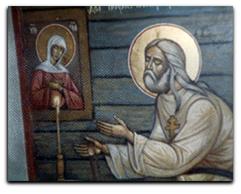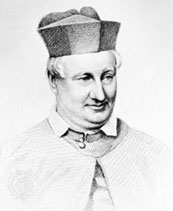Answering Patrick
 Vultus Christi reader Patrick asked:
Vultus Christi reader Patrick asked:
1. Is the icon I used to illustrate the previous post the one that was in the cell of Saint Seraphim of Sarov?
Yes, indeed. In fact, it is the icon before which Saint Seraphim of Sarov died. Its sensibility is Western; its beauty undeniable. The eyes of the Mother of God are lowered. She is the humble Handmaid of the Lord. Her expression is one of interiority and stillness, of pure attention to the Holy Spirit indwelling her Immaculate Heart. The hands, crossed over her breast, depict her reception of the Holy Spirit at the moment of the Incarnation and, again, in the Cenacle on Pentecost. They also suggest her participation in the adorable Mystery of the Most Holy Eucharist. The stars adorning her veil and garments and the cincture tied about her waist are the sign of her perpetual and ever–fruitful virginity.
 2. Why do I prefer Father Faber’s translation of Saint Louis Grignion de Montfort’s Treatise on True Devotion to the Blessed Virgin Mary?
2. Why do I prefer Father Faber’s translation of Saint Louis Grignion de Montfort’s Treatise on True Devotion to the Blessed Virgin Mary?
A long time ago when I first read Father Faber’s introduction to the book, I was smitten by it. After that, no other translation of True Devotion touched me in quite the same way. Read this excerpt from Faber’s introduction and you will understand why.
The Remedy
One man has been striving for years to overcome a particular fault, and has not succeeded. Another mourns, and almost wonders while he mourns, that so few of his relations and friends have been converted to the Faith. One grieves that he has not devotion enough; another that he has a cross to carry which is a peculiarly impossible cross to him; while a third has domestic troubles and family unhappiness which feel almost incompatible with his salvation; and for all these things prayer appears to bring so little remedy.
Mary Is Not Half Enough Preached
But what is the remedy that is wanted? What is the remedy indicated by God Himself? If we may rely on the disclosure of the saints, it is an immense increase of devotion to the Blessed Lady; but, remember, nothing short of an immense one. Here in England, Mary is not half enough preached. Devotion to her is low and thin and poor. It is frightened out of its wits by the sneers of heresy. It is always invoking human respect and carnal prudence, wishing to make Mary so little of a Mary that Protestants may feel at ease about her.
The Withering and Dwindling of Saints
Its ignorance of theology makes it unsubstantial and unworthy. It is not the prominent characteristic of our religion which it ought to be. It has no faith in itself. Hence it is that Jesus is not loved, that heretics are not converted, that the Church is not exalted; that souls which might be saints wither and dwindle; that the Sacraments are not rightly frequented, or souls enthusiastically evangelized.
Greater, Wider, Strong Devotion to Mary
Jesus is obscured because Mary is kept in the background. Thousands of souls perish because Mary is withheld from them. It is the miserable, unworthy shadow which we call our devotion to the Blessed Virgin that is the cause of all these wants and blights, these evils and omissions and declines. Yet, if we are to believe the revelations of the saints, God is pressing for a greater, a wider, a stronger, quite another devotion to His Blessed Mother. I cannot think of a higher work or a broader vocation for anyone than the simple spreading of this peculiar devotion of the Venerable Grignion De Montfort.
Incredible Efficacy
Let a man but try it for himself, and his surprise at the graces it brings with it, and the transformations it causes in his soul, will soon convince him of its otherwise almost incredible efficacy as a means for the salvation of men, and for the coming of the Kingdom of Christ. Oh, if Mary were but known, there would be no coldness to Jesus then! Oh, if Mary were but known, how much more wonderful would our faith, and how different would our Communions be! Oh, if Mary were but known, how much happier, how much holier, how much less worldly should we be, and how much more should we be living images of our sole Lord and Saviour, her dearest and most blessed Son!

Dear Fr. Mark
I am absolutely ‘hooked’ on your beautiful blog! It is so rich and full of spiritual nourishment. I am a secular Carmelite and editor of The Vine, our quarterly journal here in the UK. Would you ever give permission for me to use any of your writings – with due acknowledgement, of course. I would love to reprint the lectio divina you did on The Vine-dresser.
God bless you and thank you once again. In my prayers,
Pam Murray ocds
thank you for your response and insigths! I too love the preface by Fr. Faber.
A man in new england made a translationo of True Devotion a few years ago and had it self published’ I have found his translation helpful also.
http://www.amazon.com/Surrender-All-Perfect-Christian-Devotion/dp/0972293299/ref=pd_bbs_sr_2/102-8098917-5888916?ie=UTF8&s=books&qid=1180495980&sr=1-2
I just purchased on Amazon Fr. Faber’s translation of the True Devotion. What might be value in Faber’s translation over the work of others? Obviously Faber’s grasp of the English language and theology is a great thing but what is Mark Jacobson’s contribution adding?
Paz,
In my experience when reading spiritual classics it is good to stick with one translation as the primary one. But for some of us, certain books are life long companions and it is good over the years to read other versions, just to wake up the text and hear it with new ears. In english there are the translatins by Eddie Doherty (of Madonna House), the one in the english edition of the collected works of Montfort and the one by Jacobsen. Each one is done by someone who has discovered the “Secret of Mary” and is living it as their primary path to life in Chirst……and each brings a certain perspective and dimension to the text. at least that is my experience!
Dear Fr Mark, An Excellent post! Fr Faber has a beautiful command of the English language. The Saints are often the authentic interpreters of another saints writings. Bl Charles of Mount Argus (soon to be St. Charles) discovered the riches of St. Louis’ masterpiece and is certainly one of the reasons for his elvation to the Holy Altar this Sunday. Laus Deo